FILM MUSIC RECORDINGS REVIEWS |
|
|
FILM MUSIC RECORDINGS REVIEWS |
|
|
April 1999 Part 1
© Film Music on the Web 1999. All rights retained. Reviewers retain copyright on their reviews. Disclaimer
![]() COMPETITION WIN
a CD of your Choice from Crotchet
COMPETITION WIN
a CD of your Choice from Crotchet
![]()
| **************************************************************
Editor's Choice - CD of the Month (1) - April 1999 ************************************************************** |
| Dramatic Score
Category - 1999 Academy Award Winning Score
Nicola PIOVANI Life is Beautiful
|
|
|
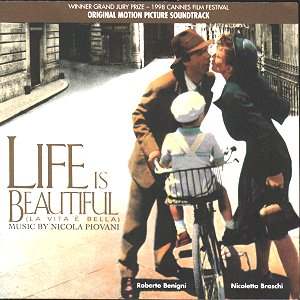
This is the Oscar-winning score that confounded us all on Film Music on theWeb (and, perhaps, many others?). Life is Beautiful is one of three 1999 Oscar-nominated scores for films set in World War II, but whereas Saving Private Ryan and The Thin Red Line treat the tragedy seriously, Benigni's film (and Piovani's music) dares to look the horror in the eye and retaliate with comedy - albeit comedy underlined with sensitivity and poignancy so that it is no less damning of the evil. Not having seen the film yet, I have to confess that I approached this album with some trepidation, after all how could it have succeeded against the might of Hollywood - John Williams's Private Ryan and Zimmer's Thin Red Line, both highly acclaimed scores. But I, presumably like the music-category voting members of the Academy, was quickly won over by its charm and enchantment.
The opening cue 'Buon Giorno Principessa' states the main theme - a simple innocent melody of homely Italian charm with guitar, piccolo, accordion and mandolin prominent. This theme is then presented as a vivacious tango in 'La Vita È Bella' which follows. 'Viva Giosué' is slower more romantic with trumpet in Italian town-band style wryly commenting. 'Grand Hotel Valse' is an expansive quick waltz in the old Viennese style. 'La Notte Di Favola' is pensive and slightly sad and nostalgic before the tango rhythms take hold again. With tremolando strings opening 'La Notte Di Fuga' a note of menace and danger is introduced for the first time - and Piovani screws up the tension with some interesting orchestration colourings and, mercifully, without having to resort to synth screechings, hissings and wailings. With 'Le Uova Nel Cappello' the atmosphere warms up again and 'Grand Hotel Fox' presents the first of several wonderful parodies. This is a foxtrot very much in the style of the 1920s - one can visualise flappers tea-dancing in the Palm Court.
'Il Treno Nel Buio' plunges us back into despair - lurking threat and danger is palpable and made implicit by insistent percussion. 'Arriva Il Carro Armato' presents the main theme a pomposo as though played by a German military band. 'Valse Larmoyante' is a gentle, elegant but almost regretful slow waltz. 'L'Uovo Di Struzzo-Danza Etiope' is another wickedly funny parody of sensual Egyptian music complete with the dancing girls' litle cymbals, while 'Krautentang' is a tuba-led take-off of German beer-garden music. 'Il Gioco Di Giosué' is in the form of a folk dance. The only source music in the album follows: the Barcarolle from Offenbach's The Tales of Hoffman with singers Montserrat Caballé and Shirley Verrett.
'Guido E Ferruccio' presents the main theme hesitatingly but most appealingly - comedy from the trumpet laced by pathos from the remainder of the ensemble - a lovely track. The album closes with the 'Abbiamo Vinto' cue at first plaintive but then the main theme emerges strongly and emphatically - life endures.
A different and rewarding film musical experience
Reviewer
Ian Lace
tar.gif)
| **************************************************************
Editor's Choice - CD of the Month (2) - April 1999 ************************************************************** |
| 1999 Academy Award Nominated Score
Hans ZIMMER – The Thin Red
Line
|
|
|
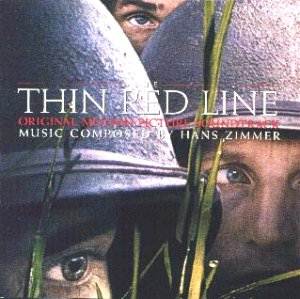
This new Oscar-nominated, Hans Zimmer score, like that of his rival nominee John Williams, for this year’s other much-praised World War II film, Saving Private Ryan, is sensitive and quietly understated. While it has nothing to equal the impact of Williams’s "Hymn to the Fallen", taken as a whole, Zimmer’s score is the better and more interestingly varied of the two.
Like John Williams, Zimmer prefers to keep battle at a distance. He is more concerned with the human scale; more concerned with the emotions and thoughts and fears of the soldiers, and of those caught up in the war. There are no heroics, no bombast. The music of the opening track creeps in slowly and quietly with ominous bass rumblings but it is as if the battles are distant, detached, unreal even: the horror, the cruelty, the pity of war muted but, in so being, made no less effective. Some cues are of considerable and impressive complexity and length (the first three are 8, 8:36 and 9:21 mins. respectively). Many tracks run into each other to form a long seamless elegy. It is a string-dominated score.
There is much to admire. The opening cue, "The Coral Atoll" I have already mentioned but it also includes a beautifully subtle and muted reference to "Christian Race" an American folk hymn. "The Lagoon" which follows begins with deep ethnic bell tollings followed by local Pacific religious wailings and chantings before edgy string dronings intrude which uncannily suggest warring aircraft, then the music moves slowly forwards almost like a slow church processional in infinite sadness and compassion with the dronings by now becoming a very quiet ostinato and only occasionally rising above pp to suggest distant theatres of operations. The cue ends with slightly faster, warmer and more romantic music that develops into a waltz - thoughts of home? "Journey to the Line" opens most imaginatively with a quiet but persistent staccato running figure (almost Morse-code-like) with lower strings entering ominously below then gradually the music lifts itself above all conflict to reach the heavens. Here, Zimmer suddenly plucks the music from the low strings and flings it to his highest strings – it is as if the sun suddenly bursts through the clouds. It is a beatific, mystical world partly Vaughan Williams partly Bruckner but wholly Zimmer. Cleverly this ecstatic mood is sustained through the next cue,"Light" which is haltingly beautiful. It is a sort of gentle Far Eastern pastoral picture (Elysian Fields?) with delectable harp figures. The writing here echoes Ravel and Puccini. This lovely track could stand as a charming little piece on its own. "Beam" brings us back down to earth with more insistent deep bell tollings that speak directly of death. This, and the next barbaric track "Air", is the closest we get to direct confrontation with the beast of war yet even here the barbarity is contrasted with the ethereal and mystical.
"Stone in my Heart" is another stunning cue with Zimmer showing considerable skill in complex contrapuntal and cross-rhythmic writing. The advance and inexorable tread of weary battle-scarred, marching soldiers is vividly evoked and the ending violin solo adds just the right touch of pathos. "The Village" is another affecting hymn-like composition building slowly up to a passionate climax. "Silence", intensely sad mournful, continues very much in the same vein but ends with the sound of distant explosions. After an ethnic hymn sung by the choir , the final cue "Sit back and relax" is ironically named for this is music of horror and dissonance reminding us that the threat of the beast of war is ever present.
A wonderful score, to my mind Zimmer’s masterpiece to date and very deserving of its Oscar nomination.
Reviewer
Ian Lace

And Paul Tonks agrees:-
It is extremely difficult to recognise this score as coming from Zimmer. There’s no accusation in that statement whatsoever. I’m just stunned. What’s so very very wonderful, is that once you’ve seen the film, this score is impossible to forget. Not that there’s any whistle-worthy melody you walk away with. It is just an absolutely perfect representation of how modern scoring techniques can work flawlessly in film.
As a superb example, the third cue on the disc ("Journey To The Line") is the closest the score gets to thematics. Its first 6 minutes (all the cues are lengthy) builds from a very subtle ticking beat into an enormous crescendo of sound. For the scene in question we are following the newly landed troop make their way to the holding point on an island. The voice-overs are specific, but the looks and body language are far more subtle at explaining that at any moment the tree-line may explode with enemy fire. This piece of music creates unbearable empathy from us towards the soldiers in this situation. Not by being eerie or anticipatory, but because like the main character we follow, it is a celebration of life. It speaks directly to the heart of the wonders of being alive and the tragedy of that being cut short.
Having mentioned the length of the cues, it’s to be noted that so often an album can sequence or edit cues together and be to the detriment of the listening experience. Mr Horner’s team I mean you ! Here, the time just flies and as with the film you could easily wallow at greater length in the company of the soundscapes and characters. The opening track ("The Coral Atoll") seems to have nothing happening for almost a minute. The ear perceives a low timbre rumble, but once the effect is expanded, on you are drawn into a whole world of expression.
The comparison I offer for consideration is with the work of Christopher Franke on the TV series Babylon 5. Not with any particular sounds or emotions. What they have in common is successfully immersing the listener into a tonal landscape for varying lengths of time (longer for the film inevitably).
With such a lot to cover, it is far better to spotlight particular moments. The lovely harp figures that open "Light" develop into the score’s most ever so delicate piece. Huge crashes in "Air" are the direct opposite, but nevertheless conform to the surrounding placid textures. The bell and wailing male voice of "The Lagoon" are used to superb effect. Most delightful of all are the incorporated uses of American folk hymn "Christian Race".
It’s a minor let down to note that having written hours of material, Zimmer still had to farm out one cue ("Beam") to fellow Media Ventures writer John Powell (Face/Off). The final cue ("Sit Back & Relax") is also from collaborator Francesco Lupica. It hardly matters though. As with all such circumstances, Zimmer oversaw their inclusions and worked them into being an integral part of the whole.
This is without doubt his masterpiece to date, and absolutely has to be seen with the film to be fully appreciated. It will take a truly great director to inspire Zimmer to further heights.
Reviewer
Paul Tonks

************************************************************** Editor's Choice - Classical Scores - April 1999
**************************************************************
Victor YOUNG The Uninvited - The Classic Film Music of Victor Young
The Moscow Symphony Orchestra and Chorus conducted by William T. Stromberg
MARCO POLO 8.225063 [69:31]
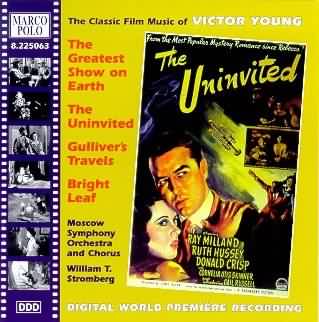 The team of Bill Stromberg & John Morgan appears incapable of doing film music any injustice. Classic filmusic is already made of gold, but these two squelch the mere attempt to tarnish it. The music of Victor Young, a paragon of the cinematic arts, receives faithful representation in their hands. The only selections, not previously unreleased, come from "Gulliver's Travels," and virtually everything is more than competent.
The team of Bill Stromberg & John Morgan appears incapable of doing film music any injustice. Classic filmusic is already made of gold, but these two squelch the mere attempt to tarnish it. The music of Victor Young, a paragon of the cinematic arts, receives faithful representation in their hands. The only selections, not previously unreleased, come from "Gulliver's Travels," and virtually everything is more than competent.The sound for the album is authentic, as are the performances from the orchestra. It is difficult to believe that these are not remastered period recordings! The extensive, if sometimes unclear, liner notes by Bill Whitaker keep interest, and additional notes by John Morgan make reading the booklet a pleasure.
The album opens with Young's witty 'Prelude (March)' from "The Greatest Show On Earth." It is a sprightly, atypically fancy circus march, unmistakably the work of Victor Young and thus unapologetically entertaining.
Following is a suite of music (reconstructed by Mr. Morgan) from "The Uninvited," arguably the finest ghost movie yet. The lovely Rachmaninoff-styled main theme in the 'Prelude' would later transform into song standard form as 'Stella by Starlight,' but its appearances throughout the suite are bare icing on the metaphorical cake. 'The Squirrel Chase' is more humorous artistry from Young, its piano runs and brief pseudo-Romantic interludes sure to garner a smile, and 'The Village' is a short, soft-spoken journey introducing a delicately humanistic side to the score. 'The Sobbing Ghost' is first mysterious, for the presence of otherworldly inhabitants now known, but then it brightens into a modest melody of amenity. This leads the listener to 'Sunday Morning - Stella's Emotions.' The cue evolves into a smooth rendering of the film's theme for Stella, but -- opposite of the track before -- becomes more mysterious. 'The Cliff' offers a full version of the Stella theme amid cyclonic modulations and the suite's first musically threatening moment. The modulations reappear in 'Grandfather and the Cliff' and the mystery motifs develop as eerily as ever; a piercing horn & trumpet call gives insight to the nature of a clouded threat. Bringing perfect closure to the suite is 'End of Ghost - Finale,' with the capsulation of the film's principal material, and the glorious final, resounding statement of the Stella theme.
The suite from "Gulliver's Travels" (again, Mr. Morgan) is less substantial, concentrating more on pure entertainment than much else, but is immensely welcome nonetheless. 'Prelude - The Scroll and Storm' is a fine overture, presenting the central themes (most taken from songs by Leo Robin & Ralph Rainger) and Young's rich arrangements. One might hypothesise that the title 'Pussyfoot March' is so descriptive of the music that further comment is unnecessary... and one would be correct...(!) 'Giant in Tow' is, for the most part, cartoonish prattle -- only a playful ditty breaks apart some of the predictability. A lengthy track titled 'Gabby and the King - The Tower - The Archers' is more agreeable as the parts gel into a definite structure. 'Finale' does as a finale should in closing, but the Moscow Symphony Chorus sounds garbled, either a case of poor recording or poor diction.
A suite from "Bright Leaf" ends the disc. The 'Prelude - Welcome to Kingsmont' seems almost tailor-made for the concert hall. It is a nigh-on perfect musical portrait of the American South. 'Sonia' paints the picture of sombre beauty, whereas 'Machine Montage' goes for the jugular, assertively marching forward. It is in 'Margaret' that Young tries for a tone of paranoia, but eventually gives way to a seductive tune. 'Tobacco Montage,' like 'Machine,' is a rough piece, and surprisingly acute. 'Suicide' makes things rougher, as it delves into death and despair in classic Hollywood fashion. 'Sonia and the Wedding' offers more beauty and Southern charm, along with a snippet from Mendelssohn and sheer romanticism (saddened by oppressive overtones). The darkness of 'Southern Vengeance - The Fire - Finale' closes the disc, the finale giving satisfying, thrilling closure to the listening experience.
The album is proof of Victor Young's skill as more than just a composer of music for easy listening. It is heartily recommendable to anyone with an interest in good music, and is a must-hear compilation for Young fans. (Old ones, too...)
Reviewer
Jeffrey Wheeler.

And Ian Lace adds:-
I heartily agree with Jeffrey Wheeler’s overall assessment - - this is a first class collection of wonderful music from a sadly neglected ‘Great of Hollywood’s Golden Age.’ I always feel it was a great pity that the late great Charles Gerhardt did not manage to include a representative sample of Victor Young’s work in his pioneering Readers Digest/RCA Classic Film Score Series. Only isolated recordings of Young’s music were available until the mid-1990s. Then his thrilling and witty score for Scaramouche (reconstructed by William Stromberg) was included on "Captain Blood" (8.223607), an earlier, 1994, release in this Marco Polo series. I thought it was the best thing on that album and I believe BBC Radio 3 producers agreed because they chose to broadcast an excerpt from it on one of their Saturday morning new recordings reviews programmes. Then we had the Koch International 1996 release (3-7365-2HI) "A Tribute to Victor Young" which included music from Shane, For Whom the Bell Tolls, Samson and Delilah, The Quiet Man and Around the World in Eighty Days.But to the music on this present album. I have heard some rather negative comments about the standard of playing by the Moscow Symphony Orchestra by some fellow critics but on this occasion they feel very much more secure (the enunciation of the Moscow chorus leaves something to be desired but I nitpick) and Victor Young’s opulent music sounds absolutely glorious. His truly memorable Stella by Starlight theme is only one element in a stunning atmospheric score for The Uninvited – today’s younger composers could take ‘a few leaves from Young’s book’ on learning how to write effective thriller/horror music without having to resort to all those awful mechanical synth effects. And notice how well he evokes all the thrills of the high wire in his piccolo writing for The Greatest Show on Earth. Victor Young’s delightful and tuneful Gulliver’s Travels music was one of the first scores that made an impression on me as a child and I was struck by how well he embraced the special Warner Bros sound in his magnificent Bright Leaf score. I mean no disrespect to either composer when I say it sounds so like the music of Max Steiner (in fact Max had to assign the task to Young because of over-commitments). This is another magnificent score with some wonderfully souring romantic melodies and evocative writing in the three montage episodes. I should mention the 32 page booklet with movie stills, very good analytical notes by Bill Whitaker and interesting informative notes about the orchestrations of these scores (large orchestras were necessary to achieve Young’s rich opulent sound) by John Morgan.
Excellent
Reviewer
Ian Lace.

Sir William WALTON Hamlet. As You Like It
Michael Sheen (Narrator) RTÉ Concert Orchestra conducted by Andrew Penny
NAXOS 8.553344 [52:43]
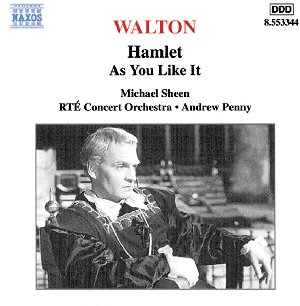
William Walton and Laurence Olivier first met in 1936 when Olivier co-starred in Paul Czinner's production of As You Like It with Elizabeth Bergner, Czinner's wife. In 1943 Olivier decided to put his Henry V on film and approached Walton to write the music. This was the first of three films on which Walton and Olivier collaborated together; the others were Hamlet, written in 1947 and released in 1948, and Richard III in 1955. The association was a happy one and Olivier said of Walton's music. 'I have always said that if it was not for the music, Henry V would not have been the success it was.'
Hamlet contained about fifty minutes of music from which Muir Mathieson, musical director of the film and a long-standing friend of the composer, edited two concert works: an orchestral poem called "Hamlet and Ophelia", and the "Funeral March", containing music from the opening and closing titles. Malcolm Sargent also collected and arranged isolated fanfares into a piece entitled Fanfare for a Great Occasion. In her book William Walton, Behind the Façade Susana, Lady Walton, lists the score of Hamlet (with a few exceptions) as one of Walton's missing scores. Nevertheless, the late Christopher Palmer, who served Walton so well as an arranger, has given us a forty-minute work entitled Hamlet (A Shakespeare Scenario in Nine Movements for Large Orchestra). These movements are 'Prelude;' 'Fanfare and Soliloquy,' in which Michael Sheen ably recreates the 'O! that this too too solid flesh would melt.' soliloquy; 'The Ghost;' 'Hamlet and Ophelia;' 'The Question,' which incorporates 'To be or not to be;' again spoken by Michael Sheen; 'The Mousetrap;' 'The Players-Entry of the Court;' 'The Play;' 'Ophelia's Death;' 'Retribution and Threnody;' and 'Finale (Funeral March)'. Some have called this music 'even finer than its predecessor, especially in the delicate use of motifs such as the poignant theme associated with Ophelia' (Gilliam Widdicombe, 1984, sleeve notes to the EMI LP entitled William Walton, Music for Shakespeare Films). I cannot agree, considering Henry V to be one of the finest of all film scores, but am profoundly grateful to have this music to add to the Walton discography.
All of the music in Hamlet displays the tragic nature of Shakespeare's play. 'The Ghost' is highly effective and eerie, as Hamlet becomes more agitated and bent on revenge, and the final moments of the Queen's retelling of Ophelia's death are decidedly poignant. The suite concludes with a threnody to those who have died and the 'Finale'-a dead march which incorporates elements of the opening Prelude.
The surprise on this CD was the suite from As You Like It, the second of four films Walton scored for Paul Czinner. The five movements of Christopher Palmer's suite (subtitled A Poem for Orchestra after Shakespeare), arranged in 1989 and played without break, are 'Prelude,' 'Moonlight,' 'Under the Greenwood Tree,' 'The Fountain,' and 'The Wedding Procession.' Appropriately satirical and pastoral, suiting the mood of the play, this is charming music written shortly after the completion of Walton's monumental 1st symphony. The French horn is effectively used in 'Moonlight,' which features exquisite use of key changes to suggest shifting light textures against a nocturnal background. Under the Greenwood Tree, omitted from the film, is restored here as the third movement sung by an unnamed soprano. 'The Fountain' depicts a delicate fountain, growing livelier, leading to the final 'Wedding Procession,' the sort of music at which Walton excels, as he was later to show in the 'Crown Imperial' and 'Orb and Sceptre' marches and such works as 'The Johannesburg Festival Overture.' This is splendid and unexpected Walton-a real find.
Andrew Penny and the RTÉ (Radio Telefís Éireann) Concert Orchestra give a good accounting on this fine CD. My only quibble would be the soprano in 'Under the Greenwood Tree,' whose voice was perhaps not quite up to the quality of the orchestral accompaniment and why I awarded four-and-a-half stars instead of five.
Reviewer
Jane Erb
tar.gif)
************************************************************** Editor's Recommendation
**************************************************************
Music for the films of Johnny Depp – An Occasional SeriesMichael KAMEN Don Juan De Marco
The London Metropolitan Orchestra conducted by the composer
A&M 540 357-2 [45:44]
Buy Now
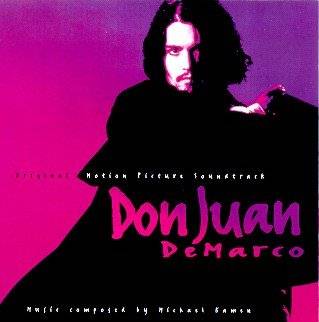
I found a copy of this 1995 album in a store in South London proving that you can find older OST recordings if you hunt hard enough! I have to confess to having enjoyed this fantasy movie very much and I reckon that this is one of Kamen’s best scores to date. His music is a perfect match for this slight parable. It treads, with ease, a very fine line between wry romantic comedy and bathos, helping to make the story of the young masked Zorro-like hero credible, and making us believe in the Don’s sexual exploits and his search for true love - his Doña Ana. Depp as Don Juan is excellent with a large-framed Marlon Brando in top form as the psychiatrist assigned to the Don’s case who comes to doubt the Don’s insanity even if he, himself, is not quite so convincing in romancing his screen wife, Faye Dunaway.
Appropriate to its fantasy setting Kamen uses heavily romantic, fragrant even, Latin music employing guitars (Julian Bream is one of the listed players) plus sweet violins and cello soloists. The opening track, the song "Have You Ever Really Loved a Woman", sung by Bryan Adams, is very much in keeping with the Don’s philosophy and his opening-scene, "last" seduction. The remaining tracks are all instrumental and although there is little variety the colour, vivacity and charm of the music carries it triumphantly through.
The vibrant opening "Habanera" is, like the Don, proud and haughty, and tenderly romantic. Another luscious tango serves to characterise "Don Juan" and gives the violin soloist, Christopher Warren-Green, and the guitarists the opportunity to show off their virtuosity - and the cello solo adds a touch of warm nostalgia (but surely the soloists breathing could have been edited out). A sweetly romantic serenade with melodramatic overtones informs the witty Korngold-like "Love at First Sight (Mother and Father)" cue. "I was born in Mexico" has well-known Mexican folk material fragrantly embellished by guitars and cimbaloms (or mandolins?). Doña Julia and Don Alfonso have slightly darker, sensuous; and then sadder more melodramatic material appropriate to Julia’s seduction of the young Don and therefore the betrayal of Alfonso, her husband, the duelling, and the tragic deaths of Alfonso and the Don’s father that ensue. Again, through both tracks there is plenty of opportunity for the soloists to show off their talents through Kamen’s colourful and dramatic but wittily ironic writing that includes a very obvious and appropriate reference to Bizet’s Carmen. These two tracks, in themselves, are worth the price of the CD.
Don Juan’s self-imposed exile in Arabia allows Kamen the opportunity to vary his palate to introduce material that suggests the heady atmosphere of the harem. It is not long before the Don’s more Latin theme interjects, however, as he is pressed into service by not only one of the Sultan’s wives but the rest of the ladies of the harem. This is another very witty creation again brilliantly orchestrated.
"Don Octavio Del Flores", the Marlon Brando psychiatrist’s self-imposed persona, used originally to treat the Don, ultimately takes Brando over. This cue is his portrait. It not only underlines the loneliness and sadness of his character, as he faces the end of his career, but it also expresses the essential warmth and romanticism that Don Juan De Marco makes him discover within himself. This is manifested when he waltzes his wife around the Paradise where Don Juan is finally reunited with his "Doña Ana"
A magic album for incurable romantics and a wonderful souvenir of a lovely film.
I wish readers well in searching for their copy – perhaps A&R might be persuaded to reissue it?
Reviewer
Ian Lace

John BARRY Collection: ZULU
The City of Prague Philharmonic conducted by Nic Raine
SILVA SCREEN FILMXCD 305 [101:36]
Music from: Zulu; Sunsilk TV ad; The Specialist; The Cotton Club; King Rat; The Tamarind Seed; The Last Valley; Love Among The Ruins; Mercury Rising; Midnight Cowboy; King Kong; Frances; My Sister’s Keeper; Hammett; Dances With Wolves; The Deep; Mister Moses. John BARRY Zulu Silva Screen
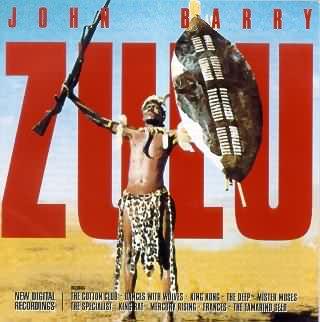
Essentially this is Silva’s Classic John Barry Volume 3. A Producer’s Note from James Fitzpatrick explains a personal longing for a stereo version of Zulu, which explains the title change. It’s also an acknowledgement of similar prominence on many a collector’s wish list. So let me deal with the obvious first - yes, the stereo recording is superb. Barry’s regular orchestrator Nic Raine does a great job conducting the City of Prague Philharmonic. Placed first, and with the special ‘fan’ association, Zulu is the benchmark by which the album will stand or fall to its listeners. Thank goodness it’s been worth the wait.
By and large, this disc also addresses a mistake made elsewhere by the second Moviola album, which Barry insisted being subtitled as ‘Action’ music. It seems achingly predictable that Barry collections are going to be made up of suites of the romantic main themes from chosen films. Of course, there is the fair share of that here, but since it also sells itself on previously unavailable material, it does well to showcase the ballsy unpredictable side of Barry too.
It is notable for being considerately sequenced. The flow from piece to piece is very easy on the ear. Some might argue that this is not too hard with Barry !
Reviewer
Paul Tonks

Collection: The GREAT BRITISH FILM MUSIC Album
Various Orchestras
SILVA SCREEN 2CDs FILMXCD 309 [153:13]
Music from: Frenzy (Ron Goodwin); Oliver Twist (Arnold Bax); Curse of the Werewolf (Benjamin Frankel); Hamlet (Patrick Doyle); A Night to Remember (William Alwyn); Coastal Command (Vaughan Williams); Stage Fright (Leighton Lucas); Far From the Madding Crowd (Richard Rodney Bennett); The Doctor from Seven Dials (Buxton Orr);The Battle of the Bulge (Benjamin Frankel; The Haunting (Humphrey Searle); Sink the Bismark! (Clifton Parker); The Dambusters (Eric Coates); Attack on the Iron Coast (Gerard Schurmann); The Sound Barrier (Malcolm Arnold); The Scars of Dracula (James Bernard); The Crimson Pirate (William Alwyn); The Red Shoes (Brian Easdale); Henry V (Patrick Doyle); The Lady Vanishes (Charles Williams/Louis Levy); Horrors of the Black Museum (Gerard Schurmann); Emma (Rachel Portman); Conquest of the Air (Arthur Bliss); The Duellists (Howard Blake); The Three Worlds of Gulliver (Bernard Herrmann); Quatermass III (James Bernard); Under Capricorn (Richard Addinsell); Malta G.C. (Arnold Bax).
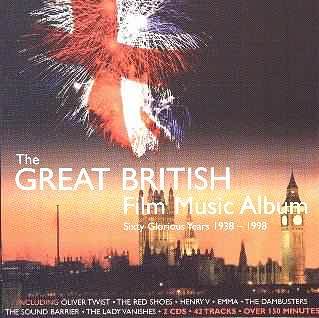
The ideal freebie gift with this CD would have been a mini cut-out Union Jack flag to have waving beside your CD player. The venture positively reeks of jingoistic pride. Hurrah !
The "Prelude" from Ron Goodwin’s Frenzy was a great place to start really since it has that heraldic fanfare quality suiting the announcement of something grand. It’s he first of several such patriotic marching fanfares. Later, there’s Clifton Parker’s "Overture" from Sink The Bismarck ! amongst so many more.
Arnold Bax’s Oliver Twist suite is a real treat, with the requisite sprightly jollyness measured by the breathtaking "The Chase". It’s nicely contrasted by the following suite from The Curse of the Werewolf, and that’s really one of the album’s strengths. The sequencing keeps you on your toes for constant surprises. On disc two, having The Lady Vanishes precede Horrors of the Black Museum is terrific jolt in style. The whole point of course, is that in celebrating Brit. produced scores this unequivocally shows it’s not just a nation of pastoral musical portraits.
There are so many highlights to choose from. I particularly enjoyed the harp parts for the "Romanza" of James Bernard’s The Scars of Dracula, and again in Rachel Portman’s regular lush style for Emma. The other "Rhapsody" of Leighton Lucas’ Stage Fright is equally lovely. There’s a great theremin sample for "The Red Shoes Ballet", as well as very subtle electronic augmentations in other cues.
About the biggest thing I have to thank this collection for is finally solving a mystery for me from last year. The grand regal march from David Newman’s Anastasia at last revealed itself to me as from Herrmann’s Three Worlds of Gulliver. Thanks for clearing that up Silva!
Reviewer
Paul Tonks

Jerry GOLDSMITH 100 Rifles
OST
FILM SCORE Silver Age Classics FSM Vol 2 No.1
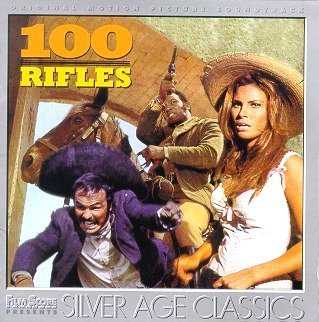
Lukas Kendall and Jeff Bond of Film Score Monthly have produced a rip-roaring western score for collectors of gritty Cowboy film music. The score decorates and injects some bruising life into a late 1960s film much influenced by the spaghetti line. The heroes/anti-heroes are played by Jim Brown, Burt Reynolds and Raquel Welch whose character, contrary to sun-splashed endings, dies towards the end of the film.
The score is brutal, intermittently dissonant, wild with the sounds of mariachi, the central American jungle (Villa-Lobos) and typically Far West Americana. The prelude rips and roars with the best - such snarlingly incisive brash horns! This mood returns. Bitterness distinguishes the hunt music when screaming trumpets calling in pain and relief arrives when the galloping, stirrup-ringing triumphalism of the prelude returns. Across the Plains, Ready for Ambush and I’ll Go Back ride confidently, high and wide and Herb Alpert trumpets echo across a hundred mesa-dotted high chaparrals. The final track ends in an exuberantly confident snorting climax.
Subtler moods are there also. A sinister sourness pervades the music for the hanging of Sarita’s father. Marimbas and scraped gourd add to the poisonous tension. The Church uses marimba, flute and harp. Several times I was sure Goldsmith must have been listening to recordings of Sibelius (Luonnotar and The Bard). For the Cliff Fight there are very original howling flutes. In Burn and Pillage/Retribution there is a startling use of prepared piano and a touch of Elizabethan dance music! Mystery and threat roll over much of this music like black clouds over a landscape. This is leavened by the Aranjuez-evocative guitar and the slow warm seduction of summer evenings.
The recording includes the original surviving mono tracks from the film but some of these suffer from distortion. The stereo tracks have been mixed from the original material recorded for the film. They are predictably open. Sadly, not all of the original material survived. As a consequence you get 16 mono tracks and only 13 stereo tracks. To these are added two mariachi tracks, one each in mono and stereo as a reflection of Goldsmith’s source music.
The recording is very well presented and superbly documented as you might expect from Kendall and Bond whose notes grace the sixteen page (English only) booklet which is mixed in with ten film or location stills. There are also small repros of the film poster art.
The CD is quite close to maximum playing time and generosity is always worth praise! All the more so when so many film music discs are very lightly filled! That said, the music is the important thing and the music is richly embroidered and gripping.
Reviewer
Rob Barnett

Editor's Note: This is a limited edition of 3,000 copies. Enquiries to Film Score Monthly - http://www.filmscoremonthly.com
Ennio MORRICONE Bulworth
OST
RCA Victor 09026 63253 2 [42:36]

I have no idea if the format of this album is a first for Morricone. Two generously lengthy suites seems more up Hans Zimmer’s strasse. The film all but tossed out the score, as reflected on a rap CD that you could easily purchase in error. I’m sure that contributed in some way to editing the material together like this. The effect is astonishing.
"Suite One: BULWORTH Part 1" is a bittersweet adagio for the most part of its near 18 minutes. Four times in its duration, the voices of Amii Stewart and Edda Dell’Orso melt in with solo performances almost leaning toward gospel in their variation on the long-line melody. Towards the end, tremolo strings announce the lead-in towards the protracted climax. It culminates in the only vocal on disc - "Where is he?" - which is almost unintelligibly drawn out. A better title could probably have explained that all this angst describes Senator Bullworth’s suicidal tendencies.
"Suite Two: BULWORTH Part 2" isn’t a much better title either ! In diametric opposition, this lengthier cue (24:41, and not 23:41 as credited) is an amalgam of the heated chase once Bullworth’s mistakes begin to follow him and the dangerous possibilities that threaten. Here the Morricone of the Spaghetti genre is perceivable, blended with a sound reminiscent of his The Untouchables march. About a third of the suite is made up by a charging repeating and accumulative phrase for piano, horn, guitar, and strings playing in an infectious staccato fashion.
The remaining material might be a little harder on the ear. Several dirge-like interludes quite spoil the momentum of the ‘chase’ material. Also some heavily atonal passages. The grand finish is again a protracted piece on high-end strings, low-end piano, and skittering bass guitar. In fact, it’s a rather scary effect !
Neither suite references the other. Presumably that is intentional, considering the smaller tracks could have been edited together in all manner of different ways. So in all, it’s quite an aural test in many ways. I hope I can say I ‘passed’ by saying I enjoyed it immensely.
Reviewer
Paul Tonks

Four Scores with African Themes:-
Rachel PORTMAN Beloved
OST Ounou Sangare; La Troupe Makandal; The African Children’s Choir; ethnic instrumentalists
EPIC /SONY 492679 2 [63:51]

Beloved is set just after the American Civil War and it is a supernatural tale which also deals with the grim psychological legacies of slavery. It is centred around Sethe, a former slave played by Oprah Winfrey who is haunted by violent memories of slavery and literally by the spirit of Beloved, her dead daughter. The film also stars Danny Glover.
Rachel Portman is the first, and, so far, the only woman to win the Oscar (in 1996 for Emma). For Beloved she has created a remarkable score concentrating on the use of instruments of African, Haitian and Brazilian descent. She also proves how well she writes for voices. Understandably, in view of the screenplay, the score is sad and melancholic, the music slow-moving.
She shares compositional honours with the singer Oumou Sangare for the opening and three or four other tracks all featuring Sangare. The use of ethnic instruments; one like an Indian or Chinese harp another like a cimbalom, adds colour and resonance. The textures and sounds in "Bluestone Road", for instance are as striking as they are unusual. The music is often appropriately coloured-church spiritual but there are also Irish Gaelic resonances. The most impressive track, "That’s Ohio" is also the longest. It begins with reflective "harp" figures before striking and affecting a capella choral music. Another memorable cue is "Uhuru" sung by The African Children’s Choir.
An interesting and unusual album; but do not attempt to listen to it all in one sitting, you might weary of its melancholy, and its lack of varied mood and tempo.
Reviewer
Ian Lace
tar.gif)
Mychael DANNA 8MM Eight Millimeter
OST
SILVA SCREEN FILMCD313
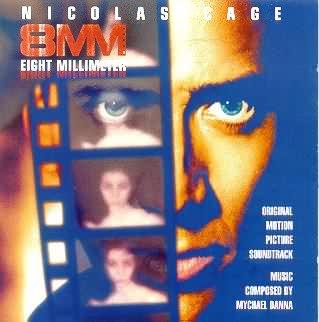
This film has yet to reach the UK and with its publicity machine some weeks away our knowledge about its plot is slim. As usual the booklet is no help at all and the news release sheet that accompanied the review copy just states - "8MM is a provocative story of a family man whose discovery of a small reel of film forces him to confront the darkest recesses of society. As his investigation leads him on a downward path of obsession, his traditional world falls away and, with it, his family is unalterably changed." Now I mention all this because much of this score is based on the music of North Africa (in fact Moroccan music consultants are credited in the CD booklet yet none of the illustrations give any clue as to this orientation rather they suggest a group of low-life undesirables (the on-screen characters, I hope) one of whom is wearing a shirt I would hate to see my worst enemy dead in!
Danna has created an above–average score for the thriller genre. It is full of atmosphere and has plenty of menace and excitement with vibrant ethnic colour and energetic rhythms. The music vividly suggests mystery and intrigue – one can imagine sultry and dangerously seductive dancing girls and an eye-patched portly villain wearing a fez practising espionage, drugs, white slavery, ritual sacrifice – or worse. The opening cue "The Projector" mysterious, threatening and unsettling, with extraordinary effects suggesting rolling dice, immediately evokes this Moroccan locale. The music develops into the second cue "The House" which is more relaxed, cosy and homely piano and orchestral meanderings with a subtle tune leaning towards the exotic. The next two tracks dwell in dark places, piling on the mystery and menace with exotic ethnic instrumentation; the music moving forward slowly. "Cindy" is a poignant piano-led cue developing the theme first stated in "The House"; this material is further developed in "What would you choose". All three cues are worthy and introduce a welcome warmer human element.
"Missing Persons" is a substantial cue and one of the most mesmerising tracks on this disc mixing very effectively Western pop/jazz/orchestral styles with ethnic music (which quickly assumes the foreground). The orchestration is very colourful using some rare and very colourful percussive effects. The track is strongly rhythmical; the sense of encroaching menace is well sustained too. (Holst’s Beni Mora is not far away in the closing pages of this cue). "Hollywood" never sounded like this, this is more "tribal-sounding" music again (but with a Western beat); it’s vibrant and includes voices and rhythmical clapping; one might imagine sultry dancing. The forces of evil seem to gather with "Unsee" and "Dance With the Devil" (the latter with hysterically insistent stick-like beating percussion over growling bass strings and native voices). We have met the weird electronic components of "The Third Man" and "Loft" (the latter accompanied by the sort of staccato string figures beloved by Herrmann) often enough before but they are imaginatively and atmospherically assembled. More weird electronics (some suggesting the distorted naggings of a shrewish wife), accompanied by ethnic dronings and percussion, inform "No answer". Moving over more weird and sinister electronics cues, sometimes with ethnic wailings, we arrive at another extraordinary six-minute cue: "Scene of the Crime". This track begins with sustained high-pitched, raw reeds with other curious wailing woodwinds below, arranged so that they suggest distant perspectives, but then they move forwards to occupy centre-stage where they dominate the music which is propelled forward ever more urgently by insistent drum rhythms reaching an almost hysterical peak in the next cue "Rainstorm". "Home" recaptures calm and serenity but there is a nervous enigmatic edge to the music which the concluding bitter-sweet melancholic "Dear Mr Wells" cue does little to dispel.
I asked James Fitzpatrick of Silva Screen if he could explain why the North African ethnic music was used: He replied – "A very good question – which I kept asking myself while watching the film! Basically I feel, as much of the film centres on the "porn low-life" of both NewYork and Los Angeles, Mychael Danna was trying to create a new "sound" rather than just go with traditional orchestrations."
Whatever, I think this is a most unusual, vividly-coloured and strongly rhythmical score.
Reviewer
Ian Lace
tar.gif)
HIDEOUS KINKY
OST Various Artists
SILVA SCREEN FILMCD311 [61:11]
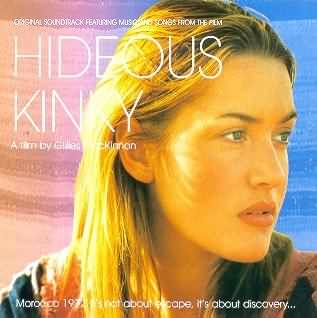
A title like that just begs unkind jibes; but I will refrain. I felt compelled to write a short review of this disc having accepted Rachel Portman’s Beloved score reviewed above. This album is comprised of about 50% source material, maybe more: songs performed by Jefferson Airplane, Canned Heat, Richie Havens and others which are outside the scope of this site and which I do not feel qualified to judge. The remainder of the material is ethnic or hybrid instrumental music, some of which may or may not have been composed for the film. "Baba, Baba Mektoubi" performed by Jil Jilala is North African instrumental and vocal music that will be colourful or just monotonous wailing according to your taste. Western ears need to adjust to the colour and subtle harmonic and rhythmic shifts of this music. "Tortoise Song" is in similar territory while "Wishing Well" is an attractive, reflective guitar solo. There is no mention of any one composer on the front cover of the CD booklet so one cannot fire missives in any concentrated direction. John Keane , however seems to be responsible for the seven-minute title track "Hideous Kinky". This is something of a hybrid embracing Western, North African and, I think, Middle Eastern forms, together with those pipes which seem to invade every kind of score these days. It begins with melancholic wailings before the music grows more strongly rhythmical to become an exotic dance; then a piano enters playing Spanish/Moorish type material above a groaning ostinato. To conventional ears, this is the most interesting track on the CD.
Reviewer
Ian Lace

Gabriel YARED The English Patient
OST performed by Academy of St Martin in the Fields
FANTASY FCD-16001 [75:11]
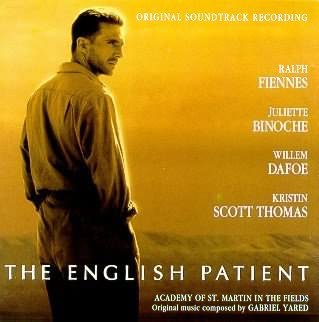
Yes, I know this is not a new album but we began operations of Film Music on the Web long after the release of the multi-Oscar winning film; and I have always wanted the excuse to include a brief review of it on this site. So here it is neatly rounding up our ‘African’ section and placed immediately before Jeffrey Wheeler’s review of Yared’s new Message in a Bottle score.
The music is a clever mosaic of North African and Hungarian and other styles of music plus source material (classic songs and Bach’s Aria from The Goldberg Variations etc). In my mind Yared’s haunting music will forever be inextricably linked with the beautifully photographed desert scenes, the doomed romance between the Ralph Fiennes and the Kristin Scott Thomas characters, and the flight of their stricken aircraft across rippling desert sands.
A marvellously evocative score which I have revisited on many occasions.
And it is still available in the shops.
Reviewer
Ian Lace
tar.gif)
Gabriel YARED Message in a Bottle
OST
ATLANTIC 83163 [73:58]

Not surprisingly, the soundtrack to "Message in a Bottle" is one of those vapid 'Music From And Inspired By' albums. I feel obligated as a reviewer to discuss the songs, but I dislike them and have no intention of wasting anyone's time in some half-wit validation of their existence. But as a courtesy, here is the song rundown: 'I Could Not Ask For More' performed by Edwin McCain, 'No Mermaid' by Sinead Lohan, 'Let Me Go' by Faith Hill, 'I Will Know Your Love' by Beth Nielsen Chapman, 'Only Lonely' by Hootie & The Blowfish, 'Don't' by Yve.n.Adam, 'Carolina' by Sheryl Crow, 'I Love You' by Sarah McLachlan, 'Fallen Angels' by Marc Cohn, 'Somewhere In The Middle' by Nine Sky Wonder, 'What Will I Do' by Clannad, and 'One More Time' by Laura Pausini. I have no use for this malodorous collection of generic pap. Those who do, have my sympathy. There is also an original song by Gabriel Yared & David Foster and Linda Thompson titled 'I'll Still Love You Then,' performed by Anna Nordell. It incorporates Yared's sweet main theme, coupled with typical Foster predictability, and unmemorable lyrics.
The disc ends with 19 minutes and ten seconds of Yared's underscore. The music received countless negative reviews for its "bloated" contribution to the film, but on disc it fares reasonably well. Yared became a Hollywood commodity following his overrated wall of clichéd melodramatic sound for "The English Patient;" here he fails to dampen the melodrama or clichés adequately, but he does use some intelligence to polish them to a high shine.
The trio of score tracks share many of the same wistful orchestrations and somewhat ambiguous melodies, making the 19 minutes seem like one extended cue. Heavy on Vienna-like strings, guitar and piano, it bears some resemblance to John Williams' "Sabrina" and "Stepmom." The track 'Theresa & Garret' merely sets the foundation of Yared's music with the string, guitar, and piano themes. 'Message in a Bottle' builds on that foundation until it forms a mildly rhythmic dance that ultimately falls in upon itself, bringing the listener back where he began. 'Dear Catherine' again builds up from the base, but this time using wordless voices and melancholy chord progressions that slowly mutate into a vibrant finale.
Regrettably, the score tracks do not make the album as a whole worth recommending to anyone other than the soundtrack completist. However, it remains noteworthy that 19 minutes of capable music is worth a lot more than 55 minutes of that lesser kind.
Reviewer
Jeffrey Wheeler

Carter BURWELL Gods and Monsters
OST
RCA 09026 63356 2 [33:44]
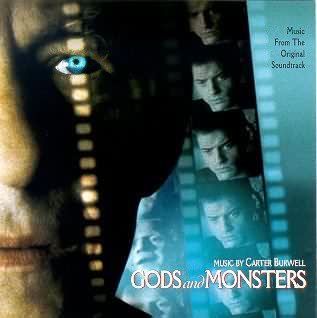
At last! A film music CD with a booklet that offers an insight into the music and the composer’s intentions! Gods and Monsters could bring Oscar glory to Ian McKellan, as James Whale, the legendary Hollywood film director /producer of such classics of the horror genre as Frankenstein, The Bride of Frankenstein, The Old Dark House and The Invisible Man. The director of the present film, Bill Condon, makes the point that when James Whale commissioned Franz Waxman to compose the music for The Bride of Frankenstein, he asked of Waxman, "Nothing will be resolved in this picture. Will you write an unresolved score for it?" Carter Burwell, one of Hollywood’s more individual composers, and best known for his collaborations with the Coen brothers, has produced music that would have fulfilled this brief. Rather than going for the obvious variations on the original celebrated Franz Waxman score, or opting for electronics, he uses a spare palate, a restrained, understated, and string-driven score that is mostly melancholic and meditative, often employing long sustained chords.
Burwell cleverly creates a sad, demoralised, desolate waltz that he associates with the horrors of the trenches in World War II, and, by implication, it is a dirge for the old European culture that war destroyed. The waltz in "Lucky Man" seems to stick in one phrase and one note seems to be an anguished cry for help. It transmogrifies into another horror of Whale’s creation - Frankenstein’s monster. This metamorphosis becomes clear in the cue "Frankenwhale" which is the only real crescendo in the score with its heavy tread and suggestion of the threat of the monster and its awful power. It is only in the final cue "Friend?" that the waltz shows any warmth.
An imaginative score but not one that many would chose for repeated listening, as music per se, it is too gloomy and spends too much time dwelling in dark places.
Reviewer
Ian Lace

Bruce BROUGHTON Lost In Space
Bruce Broughton Conducts the Sinfonia of London
INTRADA MAF 7086 [66:54]
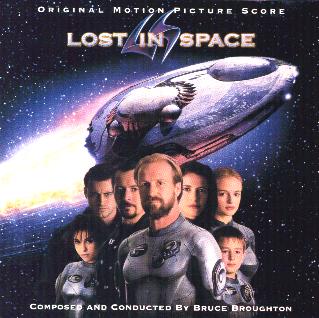
Talk about your last minute success story. Having already replaced Jerry Goldsmith at a relatively late stage, Broughton bore the brunt if state-of-the-art effects and editing techniques dictating changes in the film right until the very last minute. It’s incredible that such a coherent piece of music should result under such circumstances.
Without question the brief to Broughton was Star Wars. The style throughout is unmistakably Williams. A very obvious example being the string arrangements of "Robot Attack". The other stylistic give-away are the trumpet fanfares. All of which is absolutely spot on for the film of course. It did so try to set itself up as leading the way for a new franchise.
There is plenty to admire aside from a composer working under heavy scheduling. The music is delightfully over the top as a direct communication at just how ‘kiddie’ an audience was being pandered to. Towards the end of the film and score, there are darker passages for what seem dire circumstances for the Jupiter II crew. In "Spider Smith" the score takes a step away from the Disney tones to explore the surprisingly sinister fate of the film’s protagonist.
Broughton’s theme is certainly jolly enough. He wisely side-stepped any attempt at the Williams original (instead leaving that to the five minute fame of Apollo Four Forty). With the seriously expanded extra material here (from the song laden original I mean), this disc shows the theme to be nicely versatile. Sadly it doesn’t eclipse much of his previous melodic spotlights, and the relative failure of the film won’t propel him too far just yet. We’ll just have to continue enjoying his superior music for inferior films.
Reviewer
Paul Tonks

Chris BOARDMAN Payback
Source material and OST
VARÈSE SARABANDE VSD6003 [36:25]
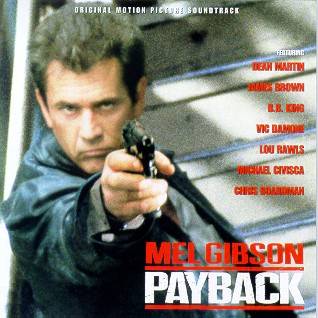
An interesting collection of material which includes Chris Boardman’s music for the film which is well worth listening to..
For any fan of the classic "singing legend" backed by Big Band or Large Orchestra, the first part of this album is a must. The tracks are:
1. Ain’t that a kick in the head Dean Martin
2. It’s a Man’s Man’s Man’s world James Brown
3. The thrill is gone B B King
4.Smoke gets in your eyes Vic Damone
5. If I had to live my life over. Lou Rawls
6. Luck be a lady Michael Civisca
7. You’re nobody till somebody loves you Dean Martin
8. Main Title Chris Boardman
9. Lynn’s Habit Chris Boardman
10. Porter Croaks Carter Chris Boardman
11.Warehouse/Finale Chris Bordman
It is a shame that the sleeve note for this album is so uninformative, not even the name of the Musical Director is given for the first seven tracks, let alone the names of any of the excellent studio musicians who perform on them. "Ain’t that a kick in the head?" is Dean Martin at his best singing with a top quality Big Band which is well recorded and well balanced. The trumpets are outstanding. James Brown’s backings on "It’s a Man’s, Man’s, Man’s World" are more orchestral in nature, but again very well executed. B B King is a classic Rhythm and Blues man, the backing to his track
has a heavy fourth beat in each bar! There is some good R&B guitar on this track called "The thrill is gone." Vic Damone has an excellent voice, although his vocals have less of a jazz feel than others on this album. "Smoke get’s in your eyes" has him in good form, his intonation and diction on this fine old song are excellent.
Lou Rawls has a superb Big Band backing on "If I had my life to live over, the Rhythm Section has a Count Basie swing and feel about it. I liked this track a great deal. "Luck be a lady to-night" finds Michael Civisca, who I must admit is new to me, in good form. The track has an interesting backing, well scored and well performed.
The final vocal track brings back Dean Martin with "You’re Nobody till Somebody Loves You", complete with ‘heavenly choir’, I prefer the first track!
Chris Boardman’s Main Title is a medium tempo Latin American theme, somewhat similar to other main title themes for similar movies. It is immaculately played by a large orchestra, the work of the Guitars and Percussion dominates. It patiently builds to a climax and then gradually fades away. I had not heard it before and I enjoyed it.
"Lynn’s Habit" should do well in the charts at present, Requiem music is all the vogue and you could not in any way call this track cheerful, although I am sure it caught the mood of the film.
Porter Croaks Carter has us back with the Latin Sound and as a track it is short but enjoyable. Warehouse/Finale closes the album, I found Chris Boardman’s music interesting, quite complicated and very well played, it is easy to see how it would make a significant contribution to the enjoyment of the film.
Reviewer
Don Mather

Elliot GOLDENTHAL In Dreams
OST
VARÈSE SARABANDE VSD6001 [47:08]
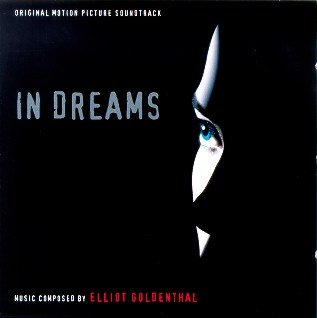
Elliott Goldenthal is one of the most original voices in film music. His style is eclectic and he often surprises. Probably one of his strongest influences is the music of Bernard Herrmann; it is certainly very apparent in this new score. He also combines electronic with conventional music more successfully than most. In this instance, however, he is not always successful – that is to say in creating a score to listen to as opposed to its primary purpose in supporting what looks like, from the pictures in the CD booklet, a dark and violent, psychological thriller. (Accepted that this may well be due more to this CD’s production process.) With this thought in mind, I raise a point of general principal. I do wish that more producers would develop a more mature taste and edit out repetitive synth effects before they become tedious and threaten the poor listener with wracking headaches. This score, more than many, illustrates that acoustic music always wins hands down over synth. The inhuman mechanistic output of the latter (I hesitate to call it noise because when used imaginatively it can be very acceptable) has very marked expressive limitations.
To the music: Goldenthal imaginatively uses a string quartet as well as an orchestra and synth effects. The opening cue begins with the string ensemble playing spiky, angst-ridden material, reminiscent of Herrmann and Psycho, appropriate to the cue’s title, "Agitato Dolorosa". About half way into this cue, the orchestra enters adding weight and more gravitas, the material is black-shadowy with a hint of bats-wings flutterings. It’s the stuff that nightmares are made of. The entry of the electronic material, for me, ruins the atmosphere. This feeling of being let down comes again later in an arresting cue "Scytheoplicity" in which racing string figures vividly suggest flight and fear but this inspiration descends into bathos when guitars enter to play some very banal material.
Lest I seem to be harping too much on the negative aspects of this score, I must add that there are undoubted strengths. I liked the meditative solo piano music that is "Claire’s Nocturne". "The Pull of Red" is strongly atmospheric and sinister; "Rubber Room Stomp" has saxophones arguing across the soundstage over agitated strings and soft muted brass growlings. "Rebecca’s Abduction" mixes the serene with the starkly dramatic, a most violent cue. The combination of electronic and conventional music is most successfully achieved in cues like: "Premonition" (strongly featuring the String Quartet) and "While We Sleep". "The Andante" is anything but peaceful; the piano might meander serenely but below lurk agitated strings and synths representing the threat in the shadows, the only relief coming from occasional warmth provided by solo violin and cello. "Elegy Ostinato" is as the title suggests; another impressive and strongly accented cue building up to a big peroration.
The album is rounded off with source songs featuring Roy Orbison, The Andrews Sisters and Elizabeth Frazer.
An interesting score with some undeniable strengths
Reviewer
Ian Lace
tar.gif)
Paul Tonks adds:-
With apologies in advance, I disagree with the rave reviews I have seen for this score. Although I thoroughly appreciate the aural landscape style Goldenthal has cultivated I rather feel that this score offers little new in that department.
I adore his scratching and bleating as well as his angelic chorus and hugely tragic adagios. Something this time just doesn’t hold it together for me. One major disturbance are the source songs thrown in the middle. After the mad, bad guitar thrashings of "Scytheoplicity" you really don't need to be crooned at by Roy Orbison with "In Dreams". I’m surprised Varese of all labels don’t appreciate the listener’s preference to have these left for the end of the disc. Perhaps this was a deliberate design by Goldenthal. Sometimes a song can blend nicely into the scores framework. I must be missing something here though.
It all bears so much similarity to Heat, Interview With the Vampire, and other bits and bobs that it’s left me quite frustrated that the wonderful relationship he has with Neil Jordan might be leaking creative juices. Everyone’s entitled to an off day right ? Composers and reviewers both...
Reviewer
Paul Tonks

David WHITAKER The Sword And The Sorcerer
Graunke SO/composer
SUPER TRACKS STCD884 [69:35]

The early 1980s seems to have been a good time for ‘sword and sorcery’ fantasy film epics. I wonder what was in the air? In any event the Conan films with their towering Poledouris scores date from that time as well. Whitaker is pretty good (though prone to eclecticism) but he is not in the Poledouris league.
The title track starts out like a Korngold tribute with a fine rollickingly confident theme. There is perhaps a touch of John Williams here as well. The Love Theme appears in a number of tracks is somewhat indebted to the great romantic theme in Rachmaninov’s rather overlooked Third Symphony. Unfortunately the sound of the Graunke SO strings is nowhere near as opulent as this music demands. This is a pity because the other departments of the orchestra perform famously.
Whitaker is extremely resourceful and has a nice line in eerily slithering strings, Militaristic marches, a long theme that might have been an ‘off-cut’ from a score by Malcolm Arnold , animal cries from the woodwind, archaic dance music and Valkyrie-like calls.
Whitaker’s name is not all that well known. The notes remind us that he wrote the music for Run Wild Run Free (1969), Scream and Scream Again (1970) and then a succession of horror films some for Hammer: Dr Jeckyll and Sister Hyde (1971), Vampire Circus, Old Dracula (1975), Death Wish II, Dominique, Vampira, Mistress Pamela, Blind Terror and Playbirds.
The notes are rather brief with the usual spattering of small stills from the movie. They tell us very little about the film.
The disc includes previously unreleased music and one track (Talon Kills Xusias) not used in the film. This is a worthwhile release, generously filled, and worth your valuable listening time.
Reviewer
© Rob Barnett
tar.gif)
Joel MCNEELY Virus
OST conducted by composer
HIPPO HIPD-40119 [50:25]
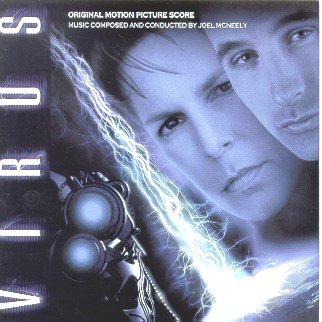
Aliens, Back to the Future, LA Confidential - they’re all here. Yet this is a cracking piece of nonsense for a movie deserving of such. Male chorus, big brassy fanfares, and ear-splitting crashes of noise all conspire to convince of the end of the world. Perhaps when it does, McNeely might be considered the chap to compose an Armageddon Symphony. I simply have to mention "Typhoon Leah" which is one of the most coherent action cues I’ve heard in some time. I remember recommendations for "Cadillac Freefall" from Terminal Velocity, and with the same degree of preposterousness about this movie, I suppose it’s fitting there should be something in common in musical approach too. You really can tell there was some fun had in going over the top here. Although I’ve cited some obvious influences already, what their incorporation into McNeely’s original music shows is just how damn fine an orchestrator he has in David Slonaker. Then it follows that it also shows how great a conductor he is - which we should already know from the Varese recordings.
This will never be music to relax to I’m afraid. You need an occasion about which you need to be considerably ‘fired up’ up to really appreciate it. I recommend listening to it while you’re about to review a CD !
Reviewer
Paul Tonks

And Rob Barnett adds:-
Violence (Squeaky Gets Creased - track 5), threat and paranoia run through the veins of this music like an infection. This is no criticism. Although there do seem to be many scores occupying this territory Joel McNeely’s is an estimable effort. The sense of panic and horror running amok in the streets is strong in Seven Footer Chase. At just over fifty minutes the pretty consistent atmosphere is nicely calculated. The music is quite fresh which is a tribute to composer and orchestrator in a world of ‘conveyor-belt’ scores written down to deadlines. There is a totally unexpected (spoilt it for you now) ‘Russian choir’ in the end-titles. This final track is rather a welcome relaxing contrast with all that has gone before.
The notes are non-existent. There are the accustomed stills from the film and a list of personnel together with other scores from the Hippo ‘stable’.
Joel McNeely is active both as composer and conductor. His revivals of Herrmann scores on Varese Sarabande have been especially fine. He is also a composer of considerable strengths and promise. I would not be surprised if he does not produce at least one ‘all-time great’ over the next decade. Until then this CD is worth hearing but is not outstanding.
Reviewer
Rob Barnett

Clint MANSELL Pi
Music from the motion Picture
SILVA SCREEN FILMCD 312
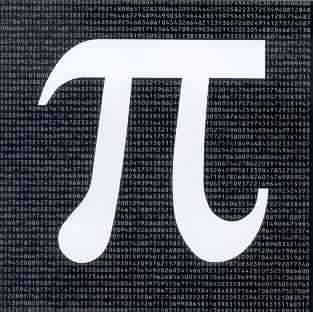
Composers and Artists: Clint Mansell, Massive Attack, Aphex Twin, David Holmes, Orbital, Autechre, Roni Size, Banco de Gaia, Gus Gus, Psilonaut, Spacetime Continuum
As easy as Pi? No, not quite!
Pi is the sixteenth letter of the Greek alphabet, it is also the symbol that represents the world's oldest mathematical mystery; the ratio of a circle's circumference to its diameter.
Now pi is a movie.
Since 1794, people have been searching for a pattern in the endless string of numbers associated with the value of pi. To date it has been calculated to over 51 billion digits and the current world record for reciting the value of pi from memory was made in 1995, when a Japanese man recited 42,000 digits in nine hours. Thankfully this accurate, though somewhat uninteresting recitation was not included on the soundtrack of the movie!
Pi, the film from Artisan Entertainments, is centred around Max Cohen, a mathematical theorist obsessed with the value of Pi. Max's computer, Euclid, pays a pivotal role in the search for the seemingly irresolvable answer. The numerical connection of Pi between spirituality, the whirling of galaxies, the stock market, our DNA and all things chaotic are mixed in this taught 16mm black and white film. This search for the infinite is psychodrama at its most claustrophobic.
The soundtrack of the movie is the latest incarnation of the electronica genre of popular music. Its roots can been witnessed in the evolution of electronic music from the avant garde of Kraftwerk and Africa Bambataa through to the more dance oriented manifestations like Acid House, Ambient, Dub and Jungle.
Original music for the movie was composed by Clint Mansell who was the front-man for the popular british band "Pop Will Eat Itself", playing guitar and keyboard from 1986-1996. Originally from Stourbridge, UK, he went to America in 1996, where he met and collaborated with Darren Aronofsky (writer and director of pi) on the soundscape for the film.
"The powerful visual effect of the film challenged me to create music equally as poignant and inspiring," Mansell says of his work.
The movie CD has an engaging format with tracks generally finishing with spoken dialogue of an apocalyptic and quasi-philosophical nature. For example "one- mathematics is the language of nature", "so what about the stock market", "evidence - the rise and fall of the Nile". These links add context to the music and are quaint in a way, but became a little irritating on repeated listening.
Mansell's eponymous opening track starts a sonic landscape of rhythmic complexity that develops with a phased, synthesised motif drawing in the listener. Just as you are expecting the motif to develop further, the drum part enters in a laid back way, pausing for breath then returning with a hard driving intensity. Pauses in the arrangement and surprising use of deep resonant bass patches keep the palette of sound exciting and interesting.
The spoken link to track two, "Petrol" by Orbital drops in to a gong sounding bright against a tense introduction with a distinct metallic tonality across the piece, the drum parts again coming in with a hard compressed urgency. The use of "riffs" (repetitive note patterns across two bars or four bars) begins an ambience that manifests itself across the CD with the use of a spanish or moorish scale towards the end the track adding drama and "eastern-ness". The very musical use of a sound that can only be described as someone running their fingers across an over-inflated metal balloon really catches the attention!.
"Kalpol Intro" by Autechre leads in with a descending bass riff covered by a soft string patch gliding across warm tones, percussion is less obtrusive with closed cymbal-like sounds and industrial steam patterns interwoven in slight variations that keep the attention focussed.
"Bucephalous Bouncing Ball" by Aphex Twin conjures the alliteration of the title and is unusual with the complexity of the percussion bringing bouncy stuff to the mind'e eye. "Watching Windows" by Roni Size has a tense intro and utilises a zither sound to great dramatic effect. The vocal is highly processed adding to the ethereal but slightly menacing mood of the track. The vocal melody incorporates indian scales and leads into a trancing two bar bass riff that is underscored by high complexity drum parts. A chromatic descending semiquaver run (a bit like a plucked mandolin) appears to counter the end phrasing of the vocal lines at times.
"Angel" by Massive Attack starts with a simple drum riff and convincing "electric bass played with a plectrum" lines. Vocals and modulated guitar chords enter and the track builds with a slow crescendo where the drums become more defined and the guitar more prominent. The continuos build is excellently executed and the sonic layering and imaginative use of percussion is well defined. Next is "We got the gun" by Clint Mansell which utilises almost "moog" synth sounds, oscillated across a powerful percussion track. A harsher track this one with gritty lyrics and a powerful riff structure, effective but painful in parts.
"No man's Land" by David Holmes is a heart-beat percussion with a riff that wouldn't be out of place in a spaghetti western, attractively countered by smooth string layers and washes of sound building slowly. "Anthem" by Gus Gus starts with delayed piano then moves rapidly into an almost Jarre-like arpeggiation building slowly with percussion emphasising mainly off-beats. The layering and crescendo are once again well executed. The next track "Drippy" by Banco de Gaia is alliterative and is an electronic potrayal of dripping things in tight synchopation, once more the crescendo to a dance drum beat. Some complex riffing here with a four beat riff across an eight beat riff that wouldn't be out of place as Tutankhumen's favourite tune. At 4:23 into the track the best bass line on the cd starts and should have all our heads nodding away like "flat eric" in the "sta-prest" advert, truly inspired. More eastern style vocal runs the track to a quieter ending on cello and bass synth with simpler percussion and distant vocals.
"Third from the Sun" by Psilonaut is more simplistic and repetitive with noises off across a basic synth bass and percussion. A slow builder again but more of respite from the intellectual challenge of the previous track. "A low Frequency Inversion Field" by Spacetime Continuum is more spiky and busy with spoken words across layered synth sounds, it lost its way a little and didn't have the same tighter feel that the previous pieces have. It felt improvised and unsure. The last track,another eponymous Mansell piece of "pi", is a reprise of the first tracks riff structure and driving percussion and rounds off the cd with a hanging synth note and a final touch of the introductory riff.
This CD grows on you and after repeated listening I would highly recommend it both as an adjunct to the movie and as a quality collection of electronic music in it's own right. If you have never had the courage to listen to what the tranced out teenager listens to then dare to listen to this.
Reviewer
Warwick Mason

© Film Music on the Web 1998. All rights retained. Reviewers retain copyright on their reviews.
![]() COMPETITION WIN
a CD of your Choice from Crotchet
COMPETITION WIN
a CD of your Choice from Crotchet
![]()
There are more >>>>>
 Search the Crotchet database from here
Search the Crotchet database from here
| Discs
on these pages are offered for sale. There is also a page of search
engines from a selection of on-line retailers
here.
Please support this web-site by buying your discs here. Disclaimer: Every effort is made to make sales links to the correct disc but, in the end, you must take responsibility for checking that what you are purchasing is what you want. Some of these discs were not actually available for sale at the time of posting but a link has been made in anticipation of their forthcoming availablility. |
Return to Index Page
e-mail Len Mullenger len@musicweb.force9.co.uk